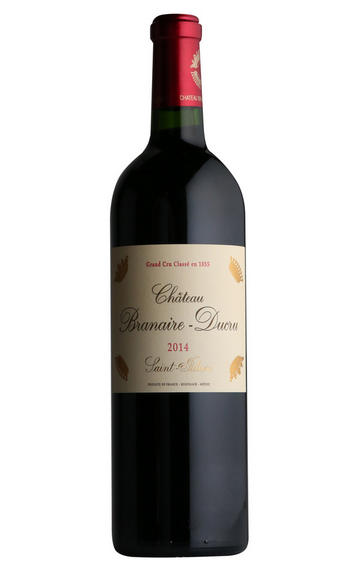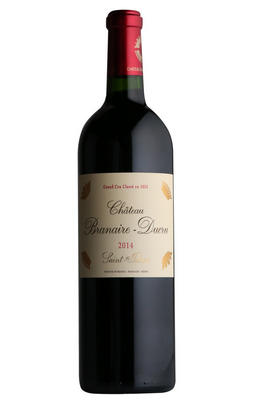
2014 Château Branaire-Ducru, St Julien, Bordeaux

Critics reviews
The 2014 Branaire Ducru has a slightly uncouth bouquet compared to its peers: blackberry, blueberry, oyster shell and just a splash of cedar. It does not quite deliver the complexity of Beychevelle or Gruaud Larose. The palate is medium-bodied with a smooth velvety texture, moderate acidity, pure black cherry and raspberry fruit. It is a seductive Saint Julien but at the moment it articulates more the winemaking than the terroir, consequently it does not provide the same engagement as its peers. Not showy, but certainly well crafted. There is more to come with bottle maturation. Tasted blind at the annual Southwold tasting.
Drink 2020 - 2032
Neal Martin, Vinous.com (March 2018)
The 2014 Branaire Ducru is soft, polished and super-inviting. Succulent red cherry, plum, lavender, spice and mint give the wine its attractive, open-knit personality, while silky tannins add to an overall impression of sensuality. The 2014 should drink well with minimal cellaring. Today, it is among the most accessible of the Saint-Juliens.
Drink 2020 - 2044
Antonio Galloni, Vinous.com (February 2017)
As soon as Patrick Maroteaux arrived, he created the second wine Duluc, named after the family who owned Branaire in 1855 and who built the current château. The first vintage was in 1988 (they started leaving serious amounts out of the blend for the first wine in 1987, but it wasn't commercialised at the time) and this is the current vintage on sale, as they hold it back from en primeur.
The nose is a little subdued, but it opens very prettily and holds itself well through the glass, clear balance, touches of black spice, subtle cinnamon and pepper, takes its time to open but it gets there, revealing black fruits, cassis and hawthorn bush. It is good, but more abrupt in its finish than the 2016.
Drink 2021 - 2033
Jane Anson, Decanter.com (December 2018)
Mid crimson. A touch less ripe than the Beychevelle but more graphite than leafy. Excellent balance between profound, dark fruit, smooth, compact tannins and fresh acidity. Medium weight and elegant already.
Drink 2022 - 2032
Jancis Robinson MW, JancisRobinson.com (November 2016)
I was disappointed not be able to taste the 2015 from this estate, but the 2014 Branaire-Ducru showed well from a bottle purchased locally. Revealing a deep ruby/plum colour and forward, sexy notes of black cherries, plums, leather, dried tobacco leaves and cedarwood, it offers impressive depth and density in the vintage, beautiful balance, and a rich, layered textured that has it already drinking nicely. It can be drunk anytime over the coming 20 years.
Drink 2018 - 2038
Jeb Dunnuck, JebDunnuck.com (November 2017)
About this WINE

Château Branaire-Ducru
Classified as a fourth growth in 1855, Ch. Branaire-Ducru makes pure and classic St Julien. The estate has recently passed from father to son: the widely respected Patrick Maroteaux – who had served at various times as president of the Union des Grands Crus de Bordeaux and the St Julien appellation – sadly passed away in 2017. His son François-Xavier has picked up the baton and continues his father’s legacy. The Maroteaux family bought the property in 1988 and have invested considerably in the vineyard and winery since. Superstar consultant Eric Boissenot advises here, as he does with many of the Left Bank’s top estates, including the Médoc’s four first growths.

St Julien
St Julien is the smallest of the "Big Four" Médoc communes. Although, without any First Growths, St Julien is recognised to be the most consistent of the main communes, with several châteaux turning out impressive wines year after year.
St Julien itself is much more of a village than Pauillac and almost all of the notable properties lie to its south. Its most northerly château is Ch. Léoville Las Cases (whose vineyards actually adjoin those of Latour in Pauillac) but, further south, suitable vineyard land gives way to arable farming and livestock until the Margaux appellation is reached.
The soil is gravelly and finer than that of Pauillac, and without the iron content which gives Pauillac its stature. The homogeneous soils in the vineyards (which extend over a relatively small area of just over 700 hectares) give the commune a unified character.
The wines can be assessed as much by texture as flavour, and there is a sleek, wholesome character to the best. Elegance, harmony and perfect balance and weight, with hints of cassis and cedar, are what epitomise classic St Julien wines. At their very best they combine Margaux’s elegance and refinement with Pauillac’s power and substance.
Ch. Léoville Las Cases produces arguably the most sought-after St Julien, and in any reassessment of the 1855 Classification it would almost certainly warrant being elevated to First Growth status.
Recommended Châteaux: Ch. Léoville Las Cases, Ch.Léoville Barton, Ch Léoville Poyferré, Ch. Ducru-Beaucaillou, Ch Langoa Barton, Ch Gruaud Larose, Ch. Branaire-Ducru, Ch. Beychevelle

Cabernet Sauvignon Blend
Cabernet Sauvignon lends itself particularly well in blends with Merlot. This is actually the archetypal Bordeaux blend, though in different proportions in the sub-regions and sometimes topped up with Cabernet Franc, Malbec, and Petit Verdot.
In the Médoc and Graves the percentage of Cabernet Sauvignon in the blend can range from 95% (Mouton-Rothschild) to as low as 40%. It is particularly suited to the dry, warm, free- draining, gravel-rich soils and is responsible for the redolent cassis characteristics as well as the depth of colour, tannic structure and pronounced acidity of Médoc wines. However 100% Cabernet Sauvignon wines can be slightly hollow-tasting in the middle palate and Merlot with its generous, fleshy fruit flavours acts as a perfect foil by filling in this cavity.
In St-Emilion and Pomerol, the blends are Merlot dominated as Cabernet Sauvignon can struggle to ripen there - when it is included, it adds structure and body to the wine. Sassicaia is the most famous Bordeaux blend in Italy and has spawned many imitations, whereby the blend is now firmly established in the New World and particularly in California and Australia.


Buying options
Add to wishlist
Description
65% Cabernet Sauvignon, 27% Merlot, 6% Petit Verdot, 2% Cabernet Franc.
This Fourth Growth St Julien estate has been performing consistently well for the past several vintages and 2014 is no exception. The nose is pretty, attractively perfumed, fresh and expressive. The palate is dominated by rich, fleshy fruit. There is a purity here, great precision and ripe tannins which grip, and offer an intense focus. High acidity, complexity and a persistence on the finish suggest this wine has excellent potential for aging. Elegant and fine, it is a wine that the château can be proud of. Bravo indeed.
Berry Bros. & Rudd
wine at a glance
Delivery and quality guarantee